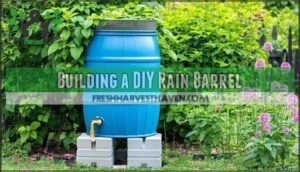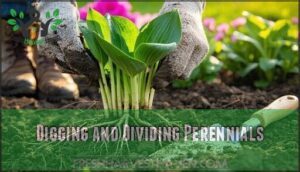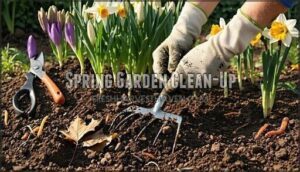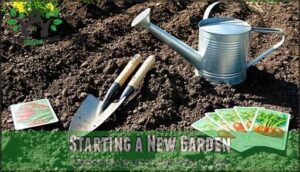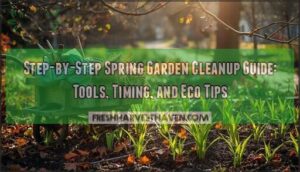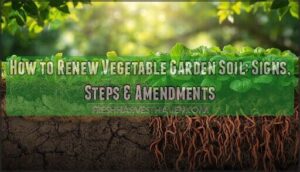This site is supported by our readers. We may earn a commission, at no cost to you, if you purchase through links.
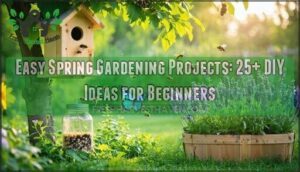
Start with simple wins like building a mason bee house from scrap wood, creating butterfly feeders with colorful sponges, or constructing a rain barrel to capture precious water.
Plant cool-season annuals, divide overgrown perennials, and try the no-dig method for new beds.
Design themed gardens like pollinator havens or mosquito-repelling herb patches.
Most projects need basic tools you already own and can be completed in a weekend.
The secret lies in choosing projects that match your skill level and garden’s unique needs.
Table Of Contents
- Key Takeaways
- Easy Spring Gardening
- Simple Garden Projects
- Spring Gardening Tasks
- Easy Gardening Techniques
- Garden Design Projects
- Frequently Asked Questions (FAQs)
- What is the easiest plant to grow in spring?
- What is the 70/30 rule in gardening?
- What is the rule of 3 in gardening?
- What is the gardening 3 year rule?
- What foods are easy to grow in spring?
- What are some spring gardening ideas?
- How do I prepare my garden for spring?
- What makes a good Spring Garden?
- What to do in the garden this spring?
- How do I choose plants for my Spring Garden?
- Conclusion
Key Takeaways
- You don’t need advanced skills or expensive tools to create a thriving garden – most projects use basic materials you already own and can be completed in a single weekend
- Start with high-impact projects like mason bee houses, rain barrels, and butterfly feeders that provide immediate benefits while supporting beneficial insects and water conservation
- Choose projects that match your garden’s specific conditions and your skill level, from simple seed starting indoors to creating specialized themed gardens like pollinator havens or mosquito-repelling herb patches
- Focus on techniques like the no-dig method and cool-season plantings that work with nature rather than against it, making gardening easier while improving soil health and plant success rates
Easy Spring Gardening
Spring brings fresh energy to your garden, and you can harness this excitement with simple DIY projects that require minimal tools and experience.
Whether you’re creating homes for beneficial insects or adding functional beauty to your outdoor space, these beginner-friendly projects will transform your garden into a thriving ecosystem.
Building a Mason Bee House
Building a mason bee house starts with choosing proper beehouse materials like untreated bamboo or drilled wood blocks. Your nesting tubes should measure 6-8mm diameter and 6 inches long.
Choose untreated bamboo or drilled wood blocks for the perfect mason bee sanctuary.
Location matters – mount your house 3-6 feet high facing southeast for morning sun. Consider exploring options for a complete bee habitat for ideal bee health.
Add predator protection with mesh barriers against birds and ants. Seasonal maintenance includes annual cleaning to prevent mites and fungi buildup, ensuring your spring gardening project supports these essential pollinators for years.
Creating a Whimsical Butterfly Feeder
Creating a whimsical butterfly feeder transforms your garden into a magical haven.
You’ll attract butterflies using simple nectar recipes and creative designs made from shallow dishes with colorful stones.
Proper feeder placement in sunny spots and regular feeder maintenance guarantee success in your spring gardening adventures, making this beginner-friendly garden project both rewarding and enchanting.
Designing a Handy Pallet Gardening Table
After setting up your butterfly feeder, you’ll need a sturdy workspace for potting and garden tasks.
Transform a free pallet into a functional gardening table with basic tools and weatherproofing treatment. Focus on comfortable table ergonomics – waist-high surfaces prevent back strain during long planting sessions.
Consider upcycling old items into planters for added functionality. Add tool storage hooks underneath and consider design variations like removable tops for easy cleaning.
This beginner-friendly outdoor project enhances any garden design.
Simple Garden Projects
Spring brings endless possibilities for improving your outdoor space with simple projects that make a real difference.
Whether you’re looking to conserve water, add visual interest, or maximize growing space, these DIY solutions require minimal skill but deliver maximum impact.
Building a DIY Rain Barrel
Capturing rainwater through DIY rain barrel construction offers significant water conservation benefits while reducing monthly utility expenses.
Harness spring rain to slash water bills while nurturing your garden naturally.
Standard food-grade plastic barrels provide the safest foundation for your garden projects.
Essential components for beginner gardening success:
- 50-80 gallon food-grade barrel for ideal storage capacity
- Spigot and overflow valve to control water flow and prevent flooding
- Fine mesh screen to block debris and prevent mosquito breeding
- Downspout diverter to channel roof runoff efficiently
- Stable platform or cement blocks for proper elevation and access
Installation tips include positioning your barrel on level ground near downspouts for maximum collection efficiency.
Consider the various options for a durable barrel spigot when planning your build.
Check local legal aspects regarding rainwater harvesting, as many municipalities offer rebates for these cost-effective garden tips.
This easy gardening project typically costs under $50 and saves up to 1,300 gallons monthly during peak seasons.
Crafting a Fanciful Rain Chain
Instead of letting rainwater rush down boring downspouts, you’ll transform this necessity into garden art. Rain chain materials like copper and aluminum offer durability while creating soothing water sounds.
Installation techniques require only basic tools and thirty minutes. This easy gardening project combines functionality with outdoor projects appeal.
| Material | Benefits |
|---|---|
| Copper | Develops beautiful patina, lasts 15-20 years |
| Aluminum | Lightweight, rust-resistant, budget-friendly |
| Galvanized Steel | Strong water diversion efficiency, affordable |
| Brass | Classic chain aesthetic design, weather-resistant |
| Glass/Ceramic | Creates whimsical visual effects in sunlight |
Cup-style designs provide better water diversion efficiency than traditional chains. Rain chain maintenance involves annual cleaning with vinegar solution. This project is a great way to add outdoor appeal to your home, and with proper care, it can last for many years, providing a soothing water sound.
Creating a Vertical Garden
Vertical gardens maximize growing space in tight areas.
You’ll transform walls, fences, or balconies into productive green spaces using simple DIY structures and smart plant selection.
- Space Saving: Wall-mounted planters and hanging systems double your growing area
- Plant Selection: Choose lightweight herbs, lettuce, and trailing plants for best results
- Irrigation Systems: Drip lines or self-watering containers reduce maintenance
- DIY Structures: Repurpose pallets, gutters, or shoe organizers as planters
- Maintenance Tips: Position frequently harvested plants at eye level for easy access.
You can find a variety of vertical garden options online.
Spring Gardening Tasks
Spring brings the perfect opportunity to tackle essential garden maintenance that sets your plants up for success all season long.
You’ll find these fundamental tasks surprisingly manageable, even as a beginner, and they’ll make a dramatic difference in your garden’s health and productivity.
Digging and Dividing Perennials
During spring’s peak growing season, you’ll breathe new life into tired perennials through strategic division. This essential garden maintenance rejuvenates overcrowded clumps while expanding your flower planting options.
| Perennial Division Tips | Digging Techniques | Tool Selection |
|---|---|---|
| Divide when shoots reach 2-4 inches | Water thoroughly day before | Sharp, sanitized spade |
| Look for hollow crowns as division signal | Use garden fork for dense clumps | Clean knife for precise cuts |
| Include 3-5 shoots per division | Lift entire clump carefully | Root pruners for woody centers |
| Replant at original depth immediately | Cut away dead center portions | Garden fork for leverage |
Focus on root health by selecting divisions with robust root systems. Spring flowers like daylilies and hostas respond excellently to this technique. For gardening for beginners, start with hardy perennials that forgive mistakes. Consistent watering prevents nutrient deficiency. Proper replanting perennials guarantees vigorous growth and abundant blooms throughout the season.
Spring Garden Clean-Up
After winter’s harsh grip loosens, your garden needs attention to thrive.
Clear away debris, sharpen tools, and prepare beds for new growth.
- Remove dead leaves and fallen branches from walkways and flower beds
- Sharpen pruning shears and clean rust from garden tools with steel wool
- Test soil pH levels and add compost to improve drainage
- Check for overwintering pests hiding under mulch or plant debris
- Assess which spring flowers survived and note bare spots needing attention
The key steps to ensure a thriving garden include checking for overwintering pests and preparing the soil for new growth.
Starting a New Garden
The excitement of starting fresh can transform any outdoor space into your dream sanctuary.
Garden planning begins with choosing location based on sunlight and drainage.
Test your soil preparation needs with a simple pH kit.
Set realistic budgeting plants limits—start small and expand later.
Essential tool selection includes a spade, rake, and watering can.
Whether you’re pursuing vegetable gardening, herb garden cultivation, or container gardening, raised beds offer excellent beginner-friendly garden ideas for success.
Mulching for Soil Health
Mulch acts as your garden’s protective blanket, offering year-round benefits for soil health.
Choose from these top mulching options:
- Organic Mulches – Wood chips, straw, and shredded leaves decompose slowly, enriching soil
- Inorganic Mulches – Landscape fabric and gravel provide long-lasting weed control
- Application Techniques – Maintain 2-3 inch mulch depth around plants, keeping material away from stems
This simple gardening practice transforms your vegetable gardening success.
Easy Gardening Techniques
You don’t need fancy equipment or years of experience to master these essential spring gardening methods.
These straightforward techniques will help you grow healthier plants with less effort and better results.
Starting Seeds Indoors
Indoor seed starting gives you a 3-6 week head start on your growing season.
You’ll achieve better germination success with the right setup and techniques.
| Supply | Purpose | Tip |
|---|---|---|
| Peat-free mixes | Eco-friendly growing medium | Reduces environmental impact by 60% |
| Grow lights | Extended daylight hours | Strengthens seedling development |
| Heat mats | Ideal soil temperature | Boosts germination rates to 95% |
Start seeds 6-8 weeks before your last frost date.
Place containers near south-facing windows or under grow lights for proper lighting needs.
Monitor soil moisture daily—seedlings need consistent dampness but not waterlogging.
When transplanting seedlings to your small garden, balcony garden, or patio garden, harden them off gradually over one week.
This organic gardening approach makes easy gardening accessible for beginners.
Using The No-Dig Method
Gardening wisdom says you can’t build soil without disturbing it, but the no-dig method proves otherwise.
You’ll layer organic materials like compost directly on your existing soil, creating rich growing conditions naturally.
This approach improves soil health while providing excellent weed control and water retention.
One key is to adjust soil pH based on testing.
Perfect for beginner benefits in any small garden, balcony garden, or patio garden setup, this organic gardening technique makes growing easy without backbreaking work.
Planting Cool-Season Annuals
Since cool-season annuals thrive in spring’s unpredictable weather, you’ll want to choose varieties with excellent frost tolerance like pansies and snapdragons.
Proper soil preparation guarantees strong root development, while understanding their moderate watering needs prevents common mistakes.
These colorful flowers make perfect companion planting partners for early vegetables, creating natural pest control while adding beauty to your cooking garden’s border rows, which is a great example of companion planting.
Growing a Salad Garden
Fresh lettuce varieties thrive in cool spring weather, making salad gardening incredibly rewarding.
Choose container salads for easy pest control and mobility.
Essential steps for success:
- Plant varieties – Mix butterhead, romaine, and arugula for diverse textures
- Apply fertilization – Use balanced liquid fertilizer every two weeks
- Monitor pests – Check regularly for aphids and slugs
- Follow harvesting tips – Cut outer leaves first, keeping centers growing
Your homegrown vegetables will elevate any cooking recipes you create.
Garden Design Projects
You can transform your garden into a specialized haven that serves both beauty and purpose through thoughtful design projects.
These targeted garden designs help you create spaces that attract beneficial wildlife, repel pests, or provide peaceful retreats right in your backyard.
Designing a Pollinator Garden
With careful planning, you’ll create a buzzing haven that supports local ecosystems.
Choose native plants like bee balm and black-eyed Susan for maximum impact. Position flowers in clusters, add a shallow water source, and avoid pesticides completely.
| Plant Selection | Garden Features |
|---|---|
| Native wildflowers (coneflowers, asters) | Shallow water dish or birdbath |
| Herb varieties (lavender, thyme) | Clustered plantings for visual impact |
| Bloom succession plants (early/late season) | Pesticide-free maintenance zone |
Creating a Cottage Garden
Cottage gardens charm with their relaxed, romantic appeal.
Mix Cottage Flowers like hollyhocks, foxgloves, and sweet peas in clusters rather than rows.
Create winding Garden Pathways using gravel or stepping stones.
Add Rustic Decor such as weathered benches and vintage watering cans.
Embrace an Informal Layout where plants spill naturally over borders, creating delightfully imperfect Charming Accents throughout your space.
Planting a Mosquito Repellent Garden
Creating mosquito-repelling gardens transforms outdoor spaces into comfortable havens. Plant citronella grass and lavender near seating areas for natural repellents.
Companion planting marigolds with herbs like basil maximizes effectiveness. Garden placement matters—position these plants where you spend time most.
Understanding mosquito biology helps: they avoid strong scents. Consider recipes using harvested herbs for cooking while enjoying pest-free evenings outdoors.
Designing a Colorful Garden
While keeping pesky bugs at bay is helpful, you’ll also want your garden to be a feast for the eyes.
Color Theory guides your plant choices—pair warm reds and oranges with cool blues and purples for visual pop.
Plan Bloom Times carefully so something’s always flowering.
Create Focal Points with bold specimens, then add Texture Combinations through varied foliage.
This approach guarantees Seasonal Interest that rivals your favorite cooking recipes for satisfaction.
Creating a Relaxing Zen Garden
While bright flowers bring energy to your garden, a zen space offers peace and relaxation through mindful design.
Transform any corner into your meditation sanctuary with these essential elements:
- Sand Garden Design – Rake patterns in fine gravel for meditative focus
- Stone Placement Ideas – Arrange 3-5 rocks asymmetrically for natural balance
- Water Feature Options – Add bamboo fountains for soothing sounds
- Plant Selection Guide – Choose moss and ferns for easy spring maintenance
- Meditation Space Layout – Include stepping stones and seating areas
Your zen garden becomes a retreat that embraces spontaneity and mindful moments year-round.
Consider adding comfortable garden furniture to enhance relaxation.
Frequently Asked Questions (FAQs)
What is the easiest plant to grow in spring?
Lettuce is your best bet for spring success. It thrives in cool weather, grows quickly from seed, and tolerates beginner mistakes beautifully. You’ll harvest fresh greens within weeks.
What is the 70/30 rule in gardening?
Studies show compost piles with 70% browns (carbon) and 30% greens (nitrogen) decompose ideally. You’ll achieve faster breakdown and avoid smelly, slimy messes when maintaining this ratio.
What is the rule of 3 in gardening?
The rule of 3 in gardening suggests planting odd numbers—groups of three, five, or seven plants create more visually appealing arrangements than even numbers.
What is the gardening 3 year rule?
Most gardeners don’t realize 40% fail because they rush the process.
The three-year rule means you’ll establish perennials in year one, see growth in year two, and enjoy full blooms by year three.
Patience pays off with stunning results.
What foods are easy to grow in spring?
You’ll find success with quick-growing crops like radishes, spinach, and lettuce. Peas, carrots, and herbs like parsley thrive in cooler spring temperatures, giving you fresh harvests.
What are some spring gardening ideas?
Don’t think you need a green thumb to succeed.
Start raised beds for 50% higher yields, try container gardening for disease-free growing, or create simple compost bins using pallets for nutrient-rich soil amendments.
How do I prepare my garden for spring?
Start by clearing debris and dead plants from beds.
Test your soil pH and add compost to improve structure.
Clean and sharpen tools, then plan your planting schedule based on frost dates.
What makes a good Spring Garden?
Raised beds increase crop yields by 50%, making them spring garden gold. You’ll want well-draining soil, native flowers for pollinators, and strategic container placement for earlier harvests and healthier plants.
What to do in the garden this spring?
Plant cool-season crops like lettuce and peas, prepare raised beds with compost, start seeds indoors under grow lights, and create pollinator-friendly spaces with native flowers for healthier harvests.
How do I choose plants for my Spring Garden?
Choose plants based on your local climate zone, sunlight conditions, and soil type.
Consider native varieties that’ll thrive naturally in your area.
Match plant needs with your garden’s specific conditions for best results.
Conclusion
Gardens bloom like new chapters, offering fresh starts and endless possibilities.
Your journey through these easy spring gardening projects transforms more than just outdoor spaces—it cultivates confidence and connection with nature.
Whether you’ve built a mason bee house, started seeds indoors, or designed a pollinator haven, you’ve proven that beautiful gardens don’t require expert skills or massive budgets.
These beginner-friendly projects set the foundation for seasons of gardening success ahead.
- https://cars.easyjet.com/en/?clientID=515834
- http://hotels.easyjet.com/content/terms.en.html?aid=347810&label=easy-homepage-tc;selected_currency=GBP
- http://parking.easyjet.com/free-if.html
- https://docs.google.com/forms/d/1GAQr3Kn1cURCVHUA82hAga1Wv8DCH0IuqDLRUrOpN7M/viewform?ts=63f4f653&entry.1515682415=https://www.merriam-webster.com/dictionary%2Feasy
- https://premium.britannica.com/mw-unabridged/?utm_source=mw&utm_medium=inline-def&utm_campaign=evergreen

